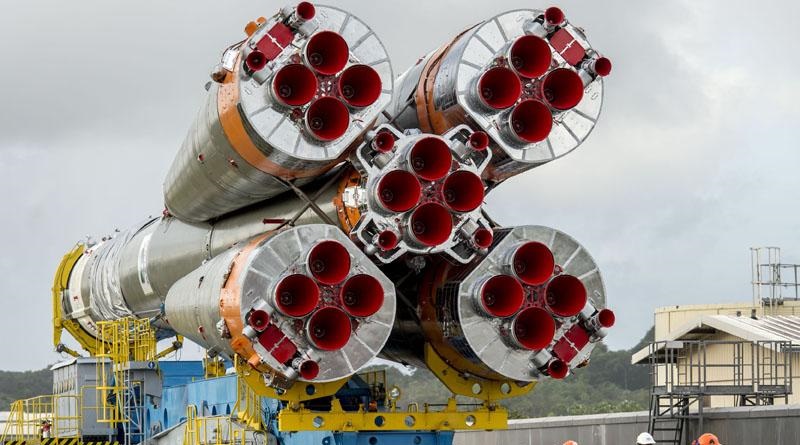Soyuz Rocket cleared for Liftoff on third Galileo Satellite Delivery of the Year
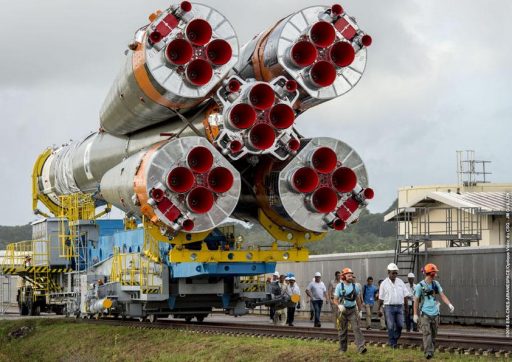
A Soyuz rocket has been cleared to thunder off from its tropical launch site in South America on Thursday, carrying a pair of European Galileo Navigation Satellites into an orbit over 20,000 Kilometers in altitude.
Liftoff is set for 11:51 UTC and the trusted Soyuz rocket will fire its three stages over the course of nine and a half minutes before handing off to the Fregat upper stage tasked with a pair of burns, spaced by a long coast phase, to put the satellites into a circular orbit for separation three hours and 48 minutes into the flight.
This is the 13th mission of the Soyuz rocket from French Guiana under operation of Arianespace and the third launch of the Russian booster from South America this year, all three having been dedicated to the European Galileo Satellite Navigation System. Managed by the European Commission, Galileo is being built at Europe’s civilian counterpart to the military-operated Global Positioning System of the United States, the Russian Glonass and the Chinese Beidou systems.
Pending a successful launch on Thursday, the constellation will consist of 12 satellites and, once the latest two additions are declared operational, the Galileo System will enter its initial operational capability, starting initial services and extensive testing. When complete by 2020, Galileo will consist of 30 satellites in three orbital planes.
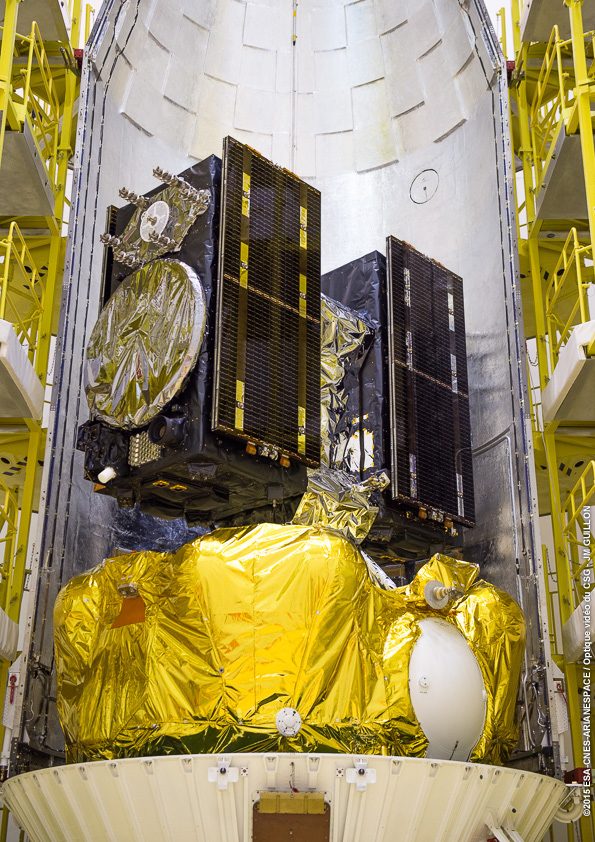
The current plan, after three Soyuz launches in 2015, calls for one Galileo launch in 2016 using the more-powerful Ariane 5 rocket to lift a group of four satellites. 2017 would see two launches, one with Ariane 5 and one with Soyuz to bring the number of satellites up to 22. Galileo will achieve its fully operational capability with 24 active satellites.
Each weighing 717 Kilograms at launch, the two Galileo satellites to head into orbit on Thursday were delivered to the Guiana Space Center in early November, being shipped from their manufacturer OHB in Bremen, Germany. Subsequently, the FM-8 and FM-9 satellites entered a processing campaign that included final checkouts and propellant loading before taking their side-by-side spots atop the Fregat Upper Stage which had undergone its preparations, including fueling, as part of its own processing campaign at the Spaceport’s Fregat Fueling Facility (FCube). FCube was specifically built to handle the Fregat Upper Stage and all its commodities that include Hydrazine Reaction Control System propellant and main propulsion system propellant components, Unsymmetrical Dimethylhydrazine and Nitrogen Tetroxide plus Helium pressurant gas. The facility consists of two areas, one for remote operation of fueling systems and preparations of processing personnel.
The Russian-built Soyuz rocket was assembled weeks in advance as its four boosters were mated to the large Core Stage of the rocket followed by the attachment of the modified Block I third stage. Flying in its 2-1B configuration, Soyuz uses the well-known design with four tapered boosters clustered around the core stage and a third stage sitting atop, but as part of the 2-1B configuration, the rocket introduced an upgraded third stage with a closed cycle engine and a significant change in the control system of the rocket, switching from and older analog system to fully digital flight control systems.
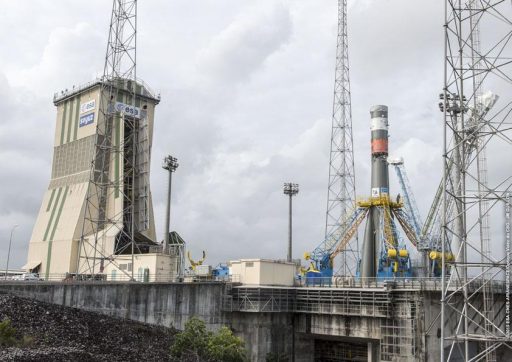
The Soyuz 2-1B rocket stands 46 meters tall and has a liftoff mass of 308 metric tons, including 272 tons of Liquid Oxygen and Kerosene propellants. It can lift up to 7,800 Kilograms into Low Earth Orbit and 1,645kg to Medium Earth Orbit, making it just powerful enough to launch a pair of Galileo satellites.
Soyuz was rolled out from its MIK assembly facility at dawn on Monday, being moved over to the ELS launch pad which, unlike all other Soyuz launch sites, features a Mobile Service Gantry which permits the vertical integration of payloads. Still missing its upper composite with the two Galileo satellites, the Soyuz was placed in its vertical liftoff position and the Service Gantry was moved into position
>>Soyuz Launch Vehicle Overview
The Galileo satellites, encapsulated in the protective payload fairing along with their Fregat MT upper stage, were rolled to the pad later on Monday and hoisted up to be precisely positioned for installation atop the Soyuz. With structural and electrical connections in place, the assembled launch vehicle went through a countdown and launch simulation on Tuesday.
Managers convened on Wednesday for the Launch Readiness Review that looked at the status of the launcher, the satellites, the tracking network and all other support stations to confirm everything was ready for the mission. No outstanding issues were found and Soyuz was cleared to head into countdown operations starting eight hours ahead of the planned liftoff time.
Countdown & Launch Sequence
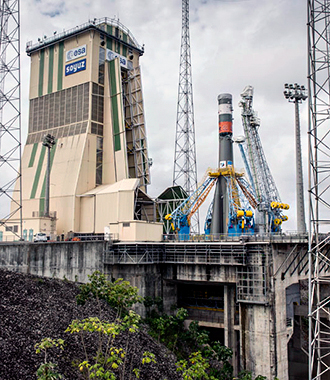
The first step of the countdown is the activation of the Soyuz launcher for pre-launch checks while teams at the pad complete final hands-on tasks such as the installation of batteries on the Soyuz, the removal of protective covers from the launcher and close-outs of the rocket and service structure.
Pending approval from the Russian State Commission, propellant loading on the Soyuz will begin four hours ahead of liftoff. Over the course of the two-hour propellant loading sequence, the boosters, core stage and third stage of the Soyuz will receive a total of 272,140 Kilograms of -183°C Liquid Oxygen oxidizer and Kerosene fuel. For launch, Soyuz is also loaded with liquid Nitrogen for booster and core stage tank pressurization and Helium to serve the same purpose on the third stage of the vehicle.
After fueling and final launch system tests, the rocket is exposed by retracting the Mobile Service Structure at L-60 minutes. Launch Command Power is activated at L-30 minutes and the spacecraft are switched to internal power 18 minutes ahead of liftoff.
Ten minutes before launch, the final pre-launch status check is performed. At the same time, the Soyuz Inertial Guidance System is activated and on-board recorders become active. At L-8 minutes, the final GO for launch is given before the countdown heads into the Automated Sequence six minutes before liftoff.
Six minutes ahead of T-0, the Soyuz Automated Countdown Sequence starts during which the launcher is put through its final set of reconfigurations for blastoff. The ground and onboard telemetry systems are activated at T-5 minutes and launch enable is switched to flight mode. Starting at T-3 minutes and 15 seconds, the RD-107A and RD-108A engines of the boosters and core stage are purged with gaseous nitrogen to condition them for ignition.
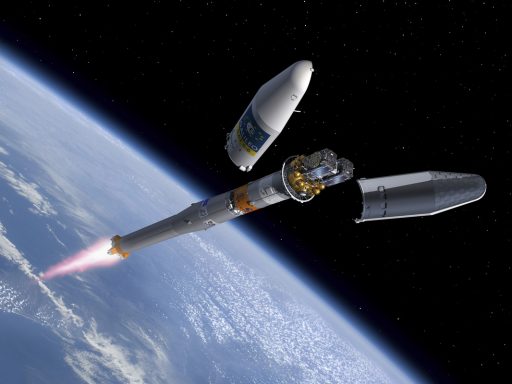
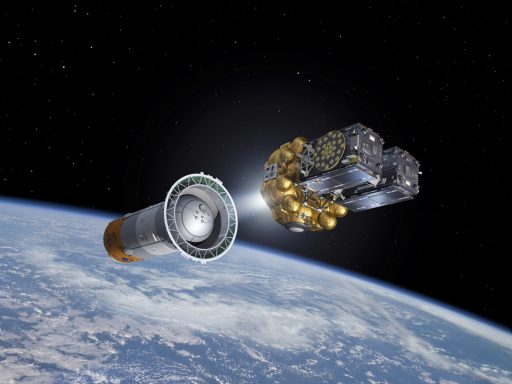
The payload umbilical is disconnected at T-2:40 and propellant tank pressurization begins at T-2:35 as all 12 tanks of the Soyuz are pressurized to flight level. Propellant Drain & Safety Valves are closed and the onboard measurement system is activated. One minute before launch, Soyuz switches to internal power and the Auto Sequencer assumes control of the vehicle. 40 seconds before launch, the third stage umbilical is disconnected and the umbilical mast retracts to its launch position.
At T-20 seconds, the Launch Command is issued and all engines of the boosters and the core stage are ignited. Turbopumps will spin up to flight speed as the engines are commanded to go to an intermediate thrust level before achieving full thrust about five seconds before liftoff.
Liftoff is set for precisely 11:51:56 UTC on Thursday
Blasting off with a total liftoff thrust of 422,000 Kilograms firing the four RD-107A and single RD-108A engine, Soyuz begins its ascent with a short vertical climb before pitching and rolling onto its pre-planned flight trajectory. Each of the four boosters of the Soyuz is 19.6 meters long, 2.68m in diameter holding 39,200kg of propellants that are expended during a 1-minute 58-second burn. Upon burnout of the Boosters, they are separated, headed for a crash landing 350 Kilometers downrange in the Atlantic Ocean.
After Booster separation, the Core Stage continues to fire its RD-108A engine providing 101,000 Kilograms of vacuum thrust. The Core is 2.95 meters in diameter and 27.8 meters long with a propellant load of 91,100 Kilograms used up over the course of a 4-minute 46-second engine burn. Soyuz uses a hot-staging technique: Two seconds after Core Stage Cutoff, the third stage ignites its RD-0124 engine and the separation system is initiated at the same time allowing the exhaust of the third stage to push the spent core stage away.
The 3rd stage of the Soyuz is 2.66 meters in diameter and 6.74 meters long holding 25,400 Kilograms of propellants that are consumed by the RD-0124 engine to provide 30,000 Kilograms of vacuum thrust.
RD-0124 is an upgrade to the RD-0110 used on the upper stage of the Soyuz 2-1A and the older variants, switching from an open to a closed cycle to increase the engine’s performance in terms of specific impulse. The engine will burn for four minutes and 29 seconds targeting a sub-orbital insertion trajectory.
Nine minutes and 24 seconds into the flight, the Fregat will be released by the third stage of the Soyuz that will then perform an avoidance maneuver by opening an oxygen valve on its side. For Fregat, the mission begins with a one-minute coast phase.
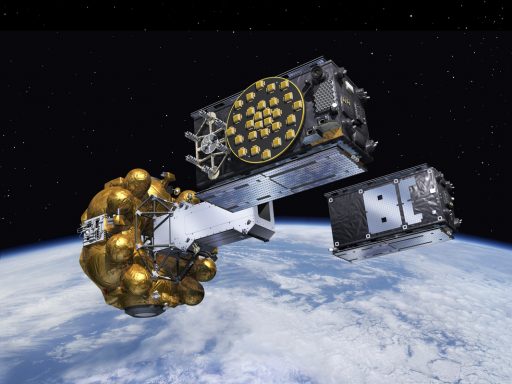
Fregat-MT is 3.35 meters in diameter and 1.5 meters long capable of holding 7,100 Kilograms of Unsymmetrical Dímethylhydrazine fuel and Nitrogen Tetroxide oxidizer. Fregat is an autonomous Upper Stage that is equipped with its own power, propulsion and control system to perform flights of up to 48 hours. S5.92 is operated in two thrust modes – 2,025 Kilograms and 1,430 Kilograms.
After a very short coast period of just one minute, the Fregat Upper Stage ignites its S5.92 engine to boost the stack into a Parking Orbit. Performing a long burn of 13 minutes and eight seconds, Fregat will boost the stack into an elliptical transfer orbit with the apogee already matching the target altitude above 23,000 Kilometers.
Following completion of the first Fregat burn, the stack will be coasting for three and a quarter hours to climb all the way up to apogee so that the second upper stage burn can raise the perigee and circularize the orbit.
The second Fregat burn is planned to commence three hours and 38 minutes into the flight and last four minutes and 22 seconds. Galileo FM-8 and FM-9 are targeting an insertion orbit of 23,222 Kilometers at an inclination of 54.95 degrees. Spacecraft separation is planned at T+3 hours 47 minutes and 57 seconds as the two spacecraft are released simultaneously, being deployed into opposite directions to prevent a collision of the satellites.
Following orbital insertion, the two spacecraft will complete a series of pre-programmed steps that include the deployment of the solar arrays, the acquisition of a stable three-axis orientation and the initiation of communications with ground stations. The spacecraft will complete several days of initial testing before heading into commissioning and starting to transmit navigation signals for further testing.
Fregat will finish its mission with two small engine burns that move it into a disposal orbit for passivation.

